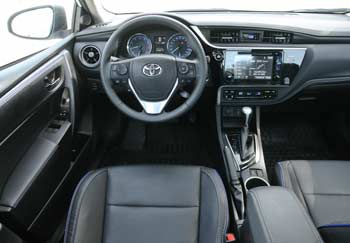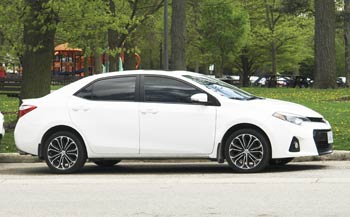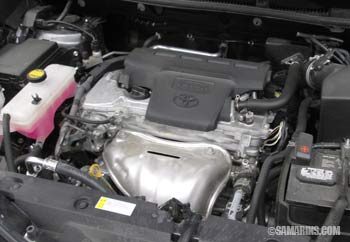Toyota Corolla sedan 2014-2019: pros and cons, common problems
By Vlad Samarin Updated: December 7, 2023
The 2014-2019 Toyota Corolla offers a blend of reliability, fuel efficiency, and safety features. While it may not excel in performance or interior luxury, it serves as a dependable and economical choice for many drivers.
It has a simple engine without a high-maintenance turbo that some other compact cars have. The rear drum brakes can last for over 150,000 miles. The interior is simple and comfortable.
Pros:
- The Corolla is one of the most reliable cars.
- Bulletproof engine that can last long with good care.
- Fuel economy.
- Low maintenance costs.
- Rear drum brakes can last very long.
- Easy driving experience, comfortable ride.
- Well-designed roomy interior.
- Holds its value well, easy to sell.
- Issues with the infotainment screen.
- The seat fabric stains easily.
- The engine feels a bit underpowered.
- The lower portion of the front bumper is easy to scrape.
Water penetrating into front doors can accumulate in the speaker connectors and cause them to corrode. This may result in one of the front door speakers not working. If the corrosion is minor and the connector can be repaired, it's a quick and simple repair. If not, the speaker or the door harness may need to be replaced. Check out these YouTube videos describing this repair.
There are complaints about some areas of the infotainment screen not being responsive or that the audio system is rebooting or freezing.
If out of warranty, replacing the screen or the unit is expensive. When buying a used Corolla, test if all areas of the touchscreen are working consistently.
If your screen is not working properly and repairing it at Toyota is too expensive, one option is to check with your local auto electronics shop if they can fit an aftermarket unit that may be cheaper. Another option is to replace the screen part (Touch Screen Digitizer). Watch this video. The screen part is sold online for $40-$60.
For phone pairing and other questions related to the infotainment system, check the Toyota Entune support website.
A bad ignition coil can cause the engine to misfire (shake and lack power). The Check Engine could stay ON or flash ON and OFF. Further diagnostics may reveal the code P0301 to P0304 (the last digit is the number of the cylinder). Replacing an ignition coil is easy and the part is not very expensive. If spark plugs are old, it's a good idea to replace all the spark plugs at the same time.
The code P0171 can be caused by a dirty or bad mass airflow sensor or vacuum leaks.
The bulletin T-SB-0086-16 explains an issue in the 2014-2016 Corolla where the fuel tank filler neck that is out of position might cause the gas cap not to close properly. As a result, the Check Engine light might come on with the code P0455 or P0456. The repair procedure involves repositioning of the fuel tank filler neck.
A noisy or leaking water pump might need to be replaced ($290-$480). It's not a very difficult job. If you have a smart key fob and the fob battery fails, you might need to hold the fob close to the start button to start the vehicle. Read more: Why a car won't start when you push the Start button? The battery in the fob lasts for about 3 years. It's easy to replace.
A failed starter motor may cause the car not to start. When turning the key, the vehicle would click but won't turn over. When this happens, the battery needs to be tested too. Replacing a starter motor costs $380-$510. Read also: 3 reasons Car won't start: 3 common causes. Steps to diagnose. Troubleshooting tips.
An alternator can fail and cause the battery warning light to come ON and the battery to be low on change. Your repair shop may charge about 1.0 hour of labor plus the cost of part ($140-320).
Advertisement
Various Toyota Safety Sense (Dynamic Cruise Control, Lane Departure, etc.) warning lights can be caused by snow or dirt blocking the front sensor or the camera on the windshield. This is a common problem in all modern cars with this type of system.
According to the owner's manual for the U.S. 2017 Corolla (page 211), the radar sensor is located behind the front grille emblem. The manual advises, "Keep the radar sensor and front grille emblem clean at all times." The same goes for the camera sensor installed on the windshield. The manual says, "If the windshield is dirty or covered with an oily film, water droplets, snow, etc., clear the windshield."Overall, the number of reported problems is small compared to other cars.
Summary: The Corolla is one of the most reliable compact cars and it won't cost a lot to maintain. The number of complaints on the NHTSA website is relatively small. NHTSA awarded the 2014-2018 Corolla sedan with a 5-star overall crash-test rating. The Corolla will hold its value well and you won't have trouble selling it.
Among competitors, we recommend the Mazda 3 and the Honda Civic.
Toyota Safety Sense (TSS-P) that includes Pre-Collision System with Pedestrian Detection, Lane Departure Alert with Steering Assist, Automatic High Beams and Dynamic Radar Cruise Control, is standard from 2017.
Related articles:
Honda Civic 2012-2015
Mazda 3 2014-2018
Toyota Corolla 2009-2013
Chevrolet Cruze 2011-2015
Engine: The 2014-2019 Corolla comes with the 132-hp 1.8L 4-cylinder 2ZR-FE double-overhead cam engine. It's a simple low-maintenance naturally aspirated (non-turbo) engine with a conventional fuel injection. Toyota has used this engine for many years and it's known to last for over 200K miles with good care.
The Corolla LE Eco is equipped with the 140-hp 2ZR-FAE engine that has a continuously variable valve lift system called Valvematic installed on intake valves. It controls how much the intake valves open depending on load, rpm and other factors.
Timing belt or timing chain? Both the 2ZR-FE and 2ZR-FAE engines come with a timing chain, there is no timing belt. A timing chain only needs to be replaced if it's stretched or worn out. If oil changes are done regularly and the engine always has the proper level of oil, a timing chain can last for the lifetime of the vehicle.
Fuel economy: The EPA rates the 2014-2016 Corolla with a CVT transmission at 29/37 mpg. The Corolla LE Eco gets 30/40 mpg. The 2017-2019 Corolla with a CVT gets 28/36 mpg city/highway on regular gasoline. This means that on a long highway trip, the automatic Corolla can go for up to 449 miles (723 km) on one tank (13.2 US gallons or 50 liters). The 2014-2016 Corolla with a manual transmission is also rated at 28/36 mpg.
Continuously Variable Transmission or CVT: From 2014, the Corolla comes with a continuously variable transmission or CVT. For buyers looking for a conventional automatic transmission, the 2014-2016 Corolla L (CE in Canada) still offers a 4-speed automatic.
The CVT in general makes a car a bit slower from the start revving the engine higher that a 5- or 6-speed automatic transmission. On the plus side, the CVT offers better fuel economy, especially in city driving. The Corolla's CVT transmission has proven to be reliable so far. Read also: pros and cons of the CVT transmission.
Does the CVT transmission need fluid change? We checked the maintenance schedule in the Warranty and Maintenance Guide for the 2018 Corolla that you can find on the US Toyota Owners portal under 'Resources'. It recommends changing the CVT fluid every 60,000 miles if the vehicle is operated under Special Operating conditions that include 'Extensive idling and/or low speed driving for a long distance such as police, taxi or door-to-door delivery use'. This basically refers to conditions that can cause the CVT fluid to overheat, so if you think that your CVT transmission has been working too hard, check with your dealer if they can change the CVT fluid.
Maintenance tips: At higher mileage, an engine might consume some amount of oil between oil changes, which means it's a good idea to check the oil level regularly (see how) and top up if needed. Spark plugs need to be replaced at 120,000 miles ($170-$220 in a repair shop).
An engine air filter needs to be changed every 30,000 miles or earlier if dirty ($25-$45). A drive (serpentine) belt needs to be inspected regularly after 60,000 miles and replaced if cracked or damaged ($85-$140). Read more about the serpentine belt.
Engine oil capacity: The oil capacity for the 2ZR-FE and 2ZR-FAE engines (Drain and refill with filter) is 4.4 US quarts or 4.2 liters according to the owner's manual. SAE 0W-20 is the recommended oil grade. Read also: Illustrated maintenance checklist.


